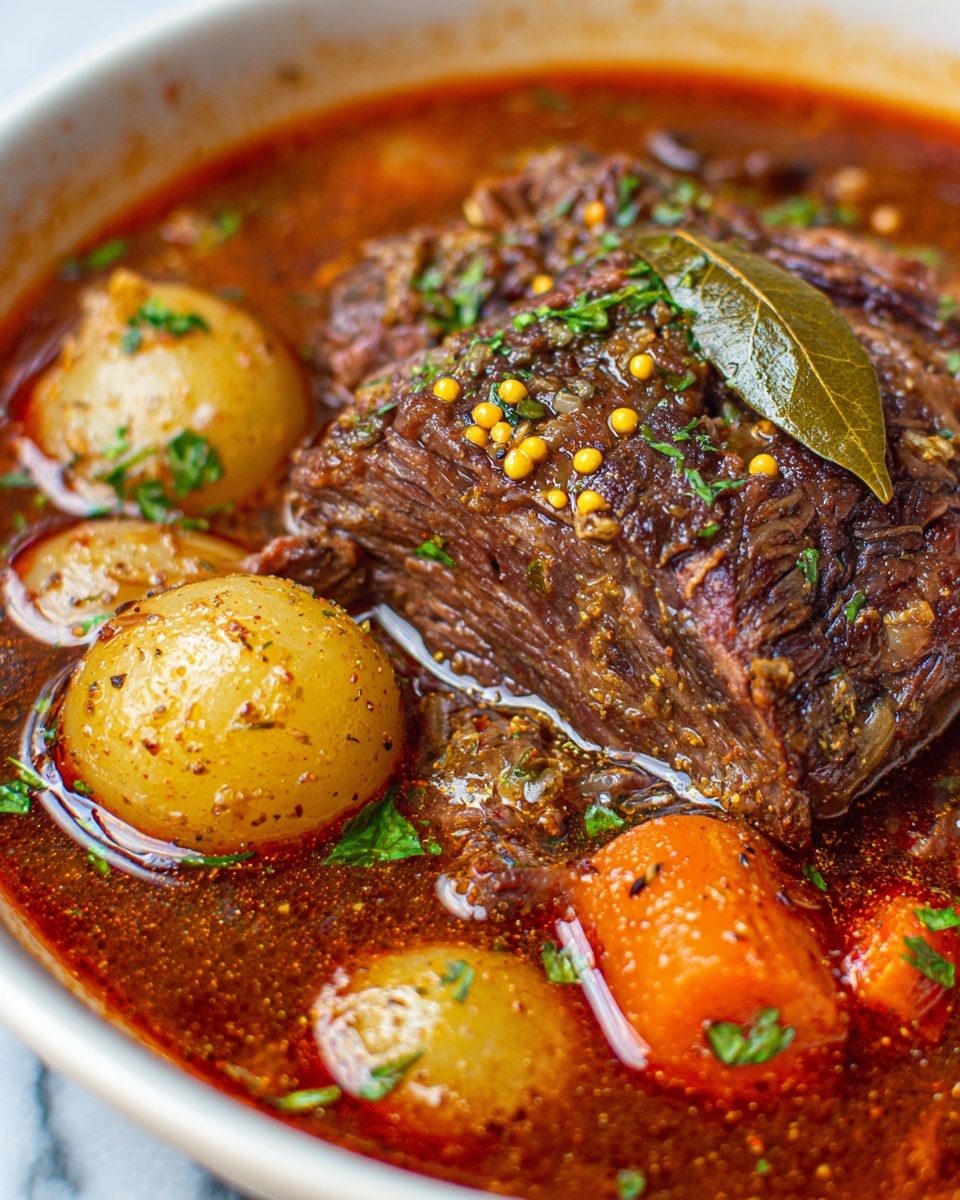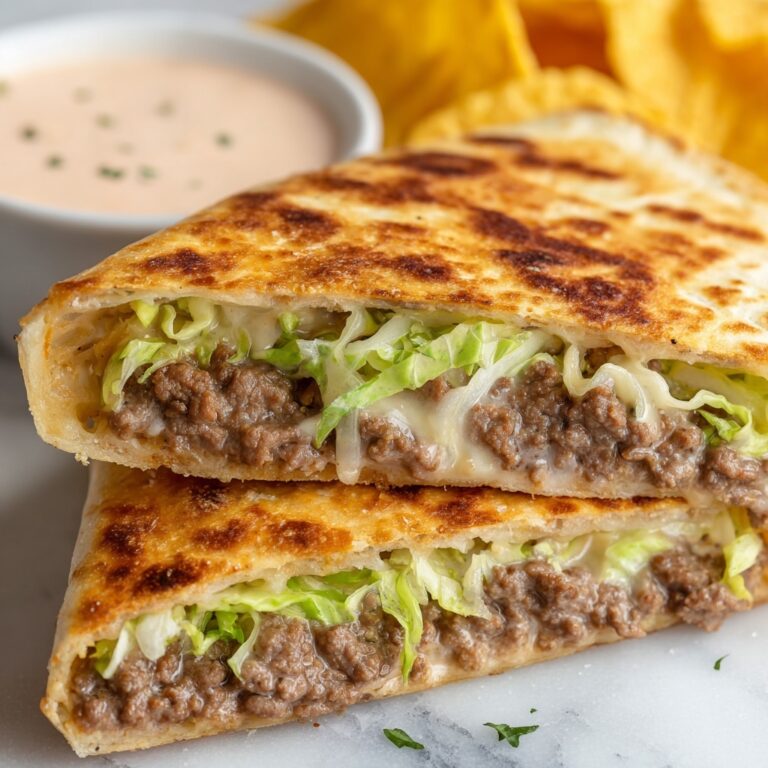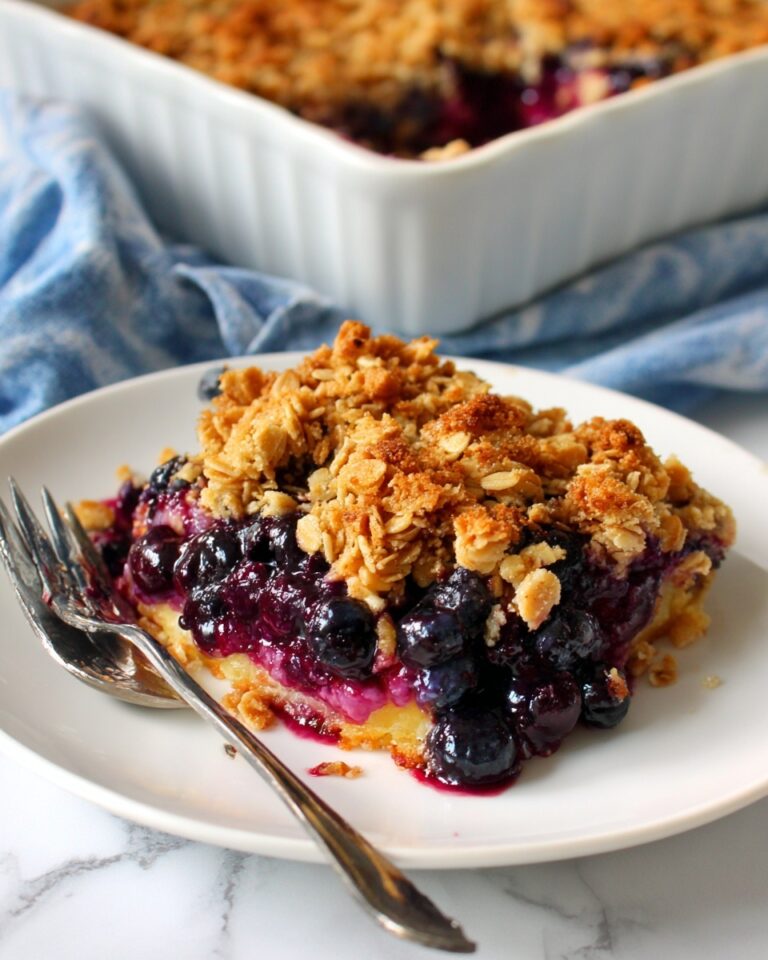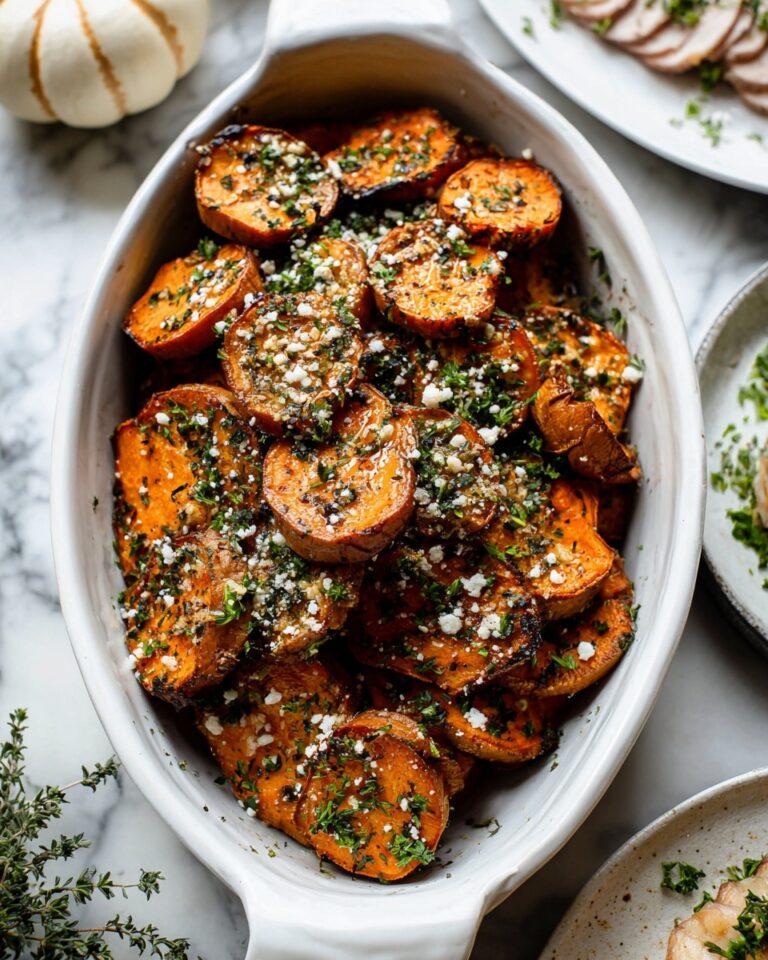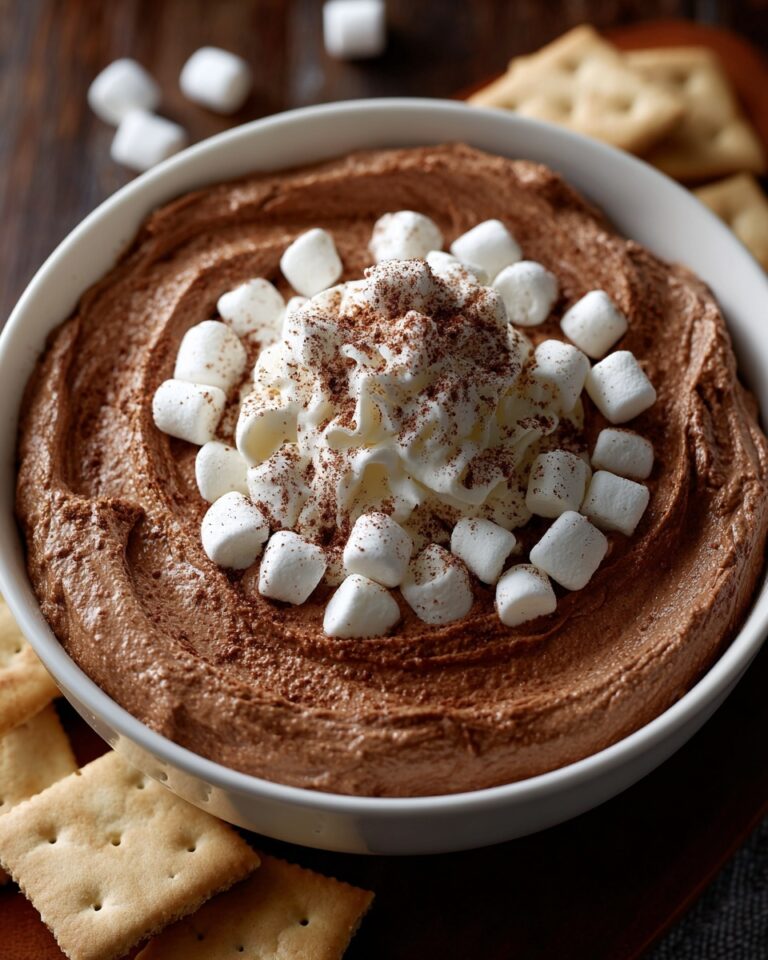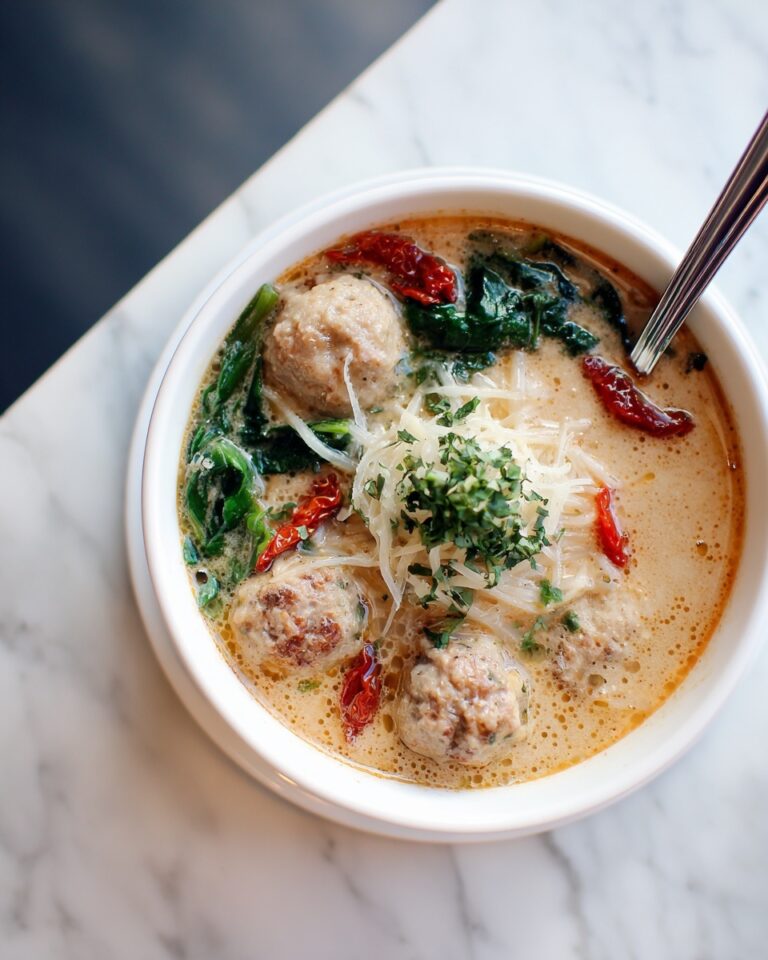If you are craving a dish that wraps you in a warm hug of deep, tangy flavors paired with tender, melt-in-your-mouth beef, this Sauerbraten German Pot Roast Recipe is destined to become your new favorite comfort meal. Rooted in tradition and bursting with a beautiful balance of savory, sweet, and slightly sour notes, it captures the heart of German cuisine perfectly. This recipe transforms a humble beef roast into an unforgettable feast, with a rich marinade and a luscious gravy that will have everyone asking for seconds.
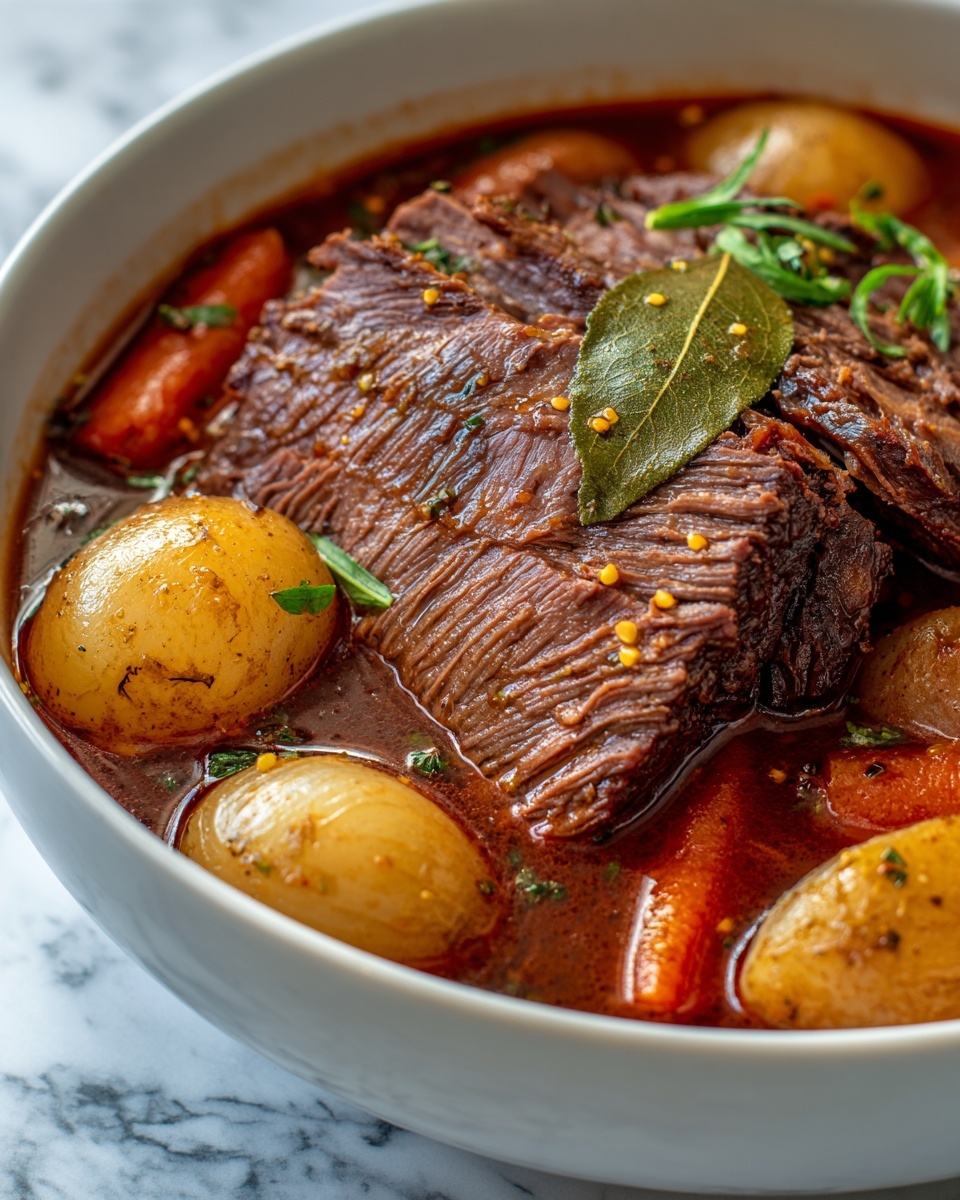
Ingredients You’ll Need
Gathering your ingredients for this Sauerbraten German Pot Roast Recipe is simpler than you might think, yet each item plays an essential role in building its complex flavor profile. From the sharp bite of vinegar to the subtle spices and fresh vegetables, every component adds depth, tenderizes the meat, or enhances the color and aroma, creating a dish that’s as impressive as it is comforting.
- 480 ml red wine vinegar or a mixture of red wine and vinegar: The acidity tenderizes the beef and adds that characteristic tang that defines Sauerbraten.
- 480 ml water: Balances the marinade’s strength and ensures the meat stays juicy.
- 1 large onion, sliced: Brings sweetness and aromatic depth during both marinating and cooking.
- 2 carrots, chopped: Adds natural sugars and earthiness that mellow throughout cooking.
- 2 celery stalks, chopped: Contributes a subtle freshness and enhances the base flavor.
- 2 cloves garlic, smashed: Infuses a gentle pungency without overpowering the dish.
- 10 whole black peppercorns: Adds warm, spicy notes that linger in the finished gravy.
- 4 whole cloves: Lends a sweet, slightly floral spice, essential to that classic Sauerbraten taste.
- 2 bay leaves: Impart subtle herbal complexity as the roast simmers gently.
- 1 teaspoon mustard seeds (optional): Introduces a subtle tang and texture variation in the marinade.
- 1 tablespoon granulated sugar or brown sugar: Balances acidity with a touch of sweetness, rounding out the marinade.
- 1.4–1.8 kg beef roast (bottom round or chuck): The star of the dish; perfect cuts for slow cooking and soak up all marinade flavors beautifully.
- Salt, to taste: Enhances all the natural flavors of the beef and marinade.
- Freshly ground black pepper, to taste: Added before searing and in the sauce for fresh heat.
- 2 tablespoons neutral oil or butter, for searing: Creates a deep brown crust locking in juices.
- 1–2 tablespoons flour (optional, for thickening): Helps achieve a rich, velvety gravy, if not using gingersnaps.
- 8–10 gingersnap cookies, crushed: The secret ingredient for that signature sweet-spicy note in the sauce.
How to Make Sauerbraten German Pot Roast Recipe
Step 1: Prepare the Marinade and Marinate the Beef
Start by combining the red wine vinegar, water, sliced onion, chopped carrots, celery, garlic, peppercorns, cloves, bay leaves, mustard seeds, and sugar in a large pot and bring this mixture to a boil. This brief heating helps meld the flavors, but the marinade must be cooled completely before use. Once cooled, submerge your beef roast in the marinade, ensuring it’s fully covered, then refrigerate for 48 to 72 hours. Don’t forget to turn the meat daily—this ensures every inch soaks in that beautiful tangy, aromatic marinade, giving the beef its signature tender and flavorful character.
Step 2: Sear the Beef
When the marinating time is over, remove the beef and pat it dry—this step promotes that essential deep browning during searing. Heat your neutral oil or butter in a heavy Dutch oven over medium-high heat, then brown the roast on all sides to develop a rich crust. This is where flavor really takes a leap forward, locking in juices and creating a beautiful foundation for the sauce.
Step 3: Sauté the Vegetables and Return the Meat
With the beef set aside, strain the marinade, reserving the liquid, and toss the soaked vegetables into the pot. Sauté them until they are aromatic and softened, unleashing a complex bouquet that perfectly sets the stage for the pot roast. Return your seared beef to the Dutch oven, nestling it among the veggies for the next slow-cook phase.
Step 4: Simmer the Pot Roast
Pour enough reserved marinade into the pot to cover about two-thirds of the beef. Bring everything to a gentle simmer, cover, and cook on low heat for approximately 2.5 to 3 hours. Your goal is utterly tender meat that slices effortlessly with a fork. Alternatively, you can transfer the covered pot to a preheated 165°C oven and slow roast to the same tender perfection. This long, gentle cooking melds the marinade’s bold flavors deeply into the beef.
Step 5: Make the Sauce
Remove the beef and let it rest on a platter, then strain the cooking liquid to separate out vegetables and spices. Return the liquid to the pot and simmer it gently while whisking in crushed gingersnap cookies or flour to thicken. This transforms the cooking liquid into a glossy, flavorful gravy with a perfect balance of tang, sweetness, and spice. Season with salt, pepper, or a pinch more sugar as needed to suit your taste.
Step 6: Serve Your Sauerbraten
Slice the rested beef and serve by ladling generous amounts of the tangy, luscious gravy over the top. And there you have it—a complete, heartwarming Sauerbraten German Pot Roast Recipe that’s simple in preparation but truly spectacular on the plate.
How to Serve Sauerbraten German Pot Roast Recipe
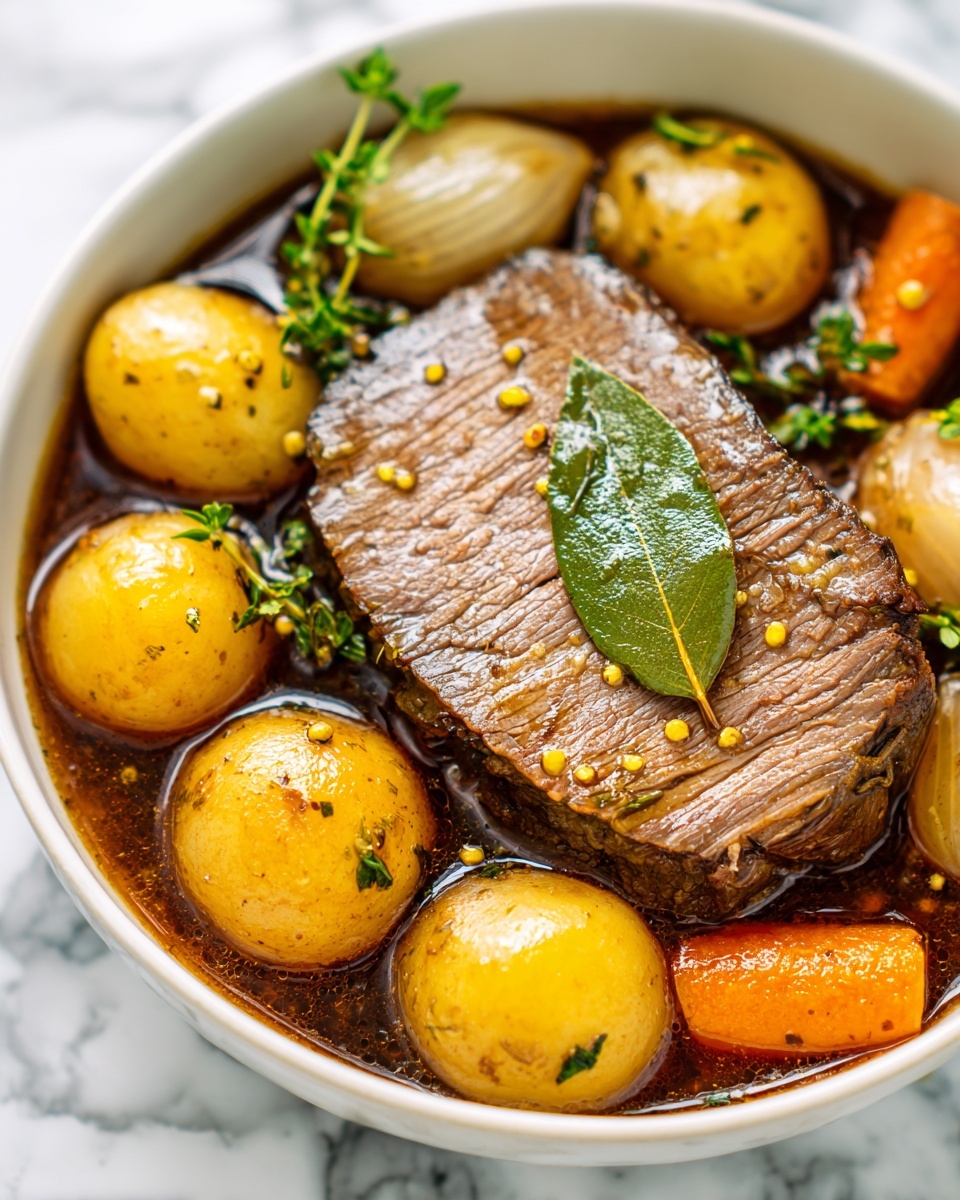
Garnishes
For an inviting presentation, garnish your Sauerbraten with fresh parsley or chives, which add a pop of green and a hint of freshness to contrast the rich sauce. A few whole gingersnap crumbs sprinkled on top can also create a lovely rustic touch while reinforcing the sweet-spicy flavor profile unique to this dish.
Side Dishes
The best sides for Sauerbraten keep things traditional to complement those bold German flavors. Think braised red cabbage, buttery boiled potatoes, soft potato dumplings, or fluffy spaetzle. These all help soak up the gorgeous gravy, ensuring every bite is bursting with flavor and warmth.
Creative Ways to Present
Feeling adventurous? Serve your Sauerbraten German Pot Roast Recipe on a rustic wooden board with a side of pickled vegetables for a tart counterpoint. Or try mini portions in individual braiser pots for an elegant dinner party touch. Either way, this dish shines whether plated familiarly or kissed with a contemporary twist.
Make Ahead and Storage
Storing Leftovers
If you happen to have leftovers, store them in an airtight container in the refrigerator for up to 3 to 4 days. Because the flavors meld even more after resting, the next day’s meal will taste just as delightful, if not better.
Freezing
Sauerbraten freezes wonderfully. Portion the beef and gravy into freezer-safe containers or heavy-duty zip bags, leaving some space for expansion. Frozen Sauerbraten will keep for up to 3 months. When thawed slowly in the fridge, the beef maintains its tender texture and robust flavor.
Reheating
To reheat, warm your Sauerbraten gently over low heat on the stovetop to prevent drying out, stirring occasionally. You might want to add a splash of water or broth to loosen the sauce. This method keeps the beef tender and the sauce silky, perfect for a quick, comforting meal any time.
FAQs
What cut of beef is best for Sauerbraten?
The classic cuts for Sauerbraten are bottom round and chuck roast, as they are tough enough to benefit from the long marinating and slow cooking process, resulting in tender, flavorful meat.
Can I skip the marinating process?
The marinating step is essential for the signature tangy flavor and tender texture of Sauerbraten, so it’s not recommended to skip it. However, if short on time, marinating for at least 24 hours will still impart some great flavors.
What can I use if I don’t have gingersnap cookies?
If gingersnaps are unavailable, you can thicken the sauce with flour or cornstarch, but the unique sweet-spicy notes from the cookies are a highlight of this recipe and well worth the search.
Is Sauerbraten always sour?
While Sauerbraten is known for its tangy marinade, the balance of sugar and spices ensures it is never overwhelmingly sour. It’s a harmonious blend of sweet, sour, and savory that delights the palate.
Can I make Sauerbraten in a slow cooker?
Absolutely! After marinating, sear the beef and transfer everything to a slow cooker. Cook on low for about 6 to 8 hours until tender, then finish the sauce as directed for a hands-off version of this classic.
Final Thoughts
Nothing brings people together quite like a lovingly prepared Sauerbraten German Pot Roast Recipe. Its rich history, perfectly balanced flavors, and tender beef make it a true culinary treasure to enjoy year-round. Whether for a cozy family dinner or a special occasion, I encourage you to try this recipe and experience the warmth and depth it brings to your table. Get ready for rave reviews and a new favorite in your recipe collection!
Print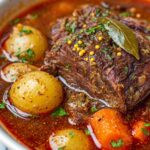
Sauerbraten German Pot Roast Recipe
- Prep Time: 15 minutes (plus 48-72 hours marinating)
- Cook Time: 2.5 to 3 hours
- Total Time: 2 days 15 hours (including marinating)
- Yield: 6 servings
- Category: Main Course
- Method: Stovetop
- Cuisine: German
Description
Sauerbraten is a classic German pot roast featuring a tender beef roast marinated for several days in a flavorful mixture of red wine vinegar, spices, and vegetables. This slow-cooked dish is seared to perfection, simmered until fork-tender, and served with a rich, tangy gravy thickened with gingersnap cookies. Ideal for a comforting family meal, it pairs beautifully with traditional sides like red cabbage, boiled potatoes, or spaetzle.
Ingredients
Marinade
- 480 ml red wine vinegar or a mixture of red wine and vinegar
- 480 ml water
- 1 large onion, sliced
- 2 carrots, chopped
- 2 celery stalks, chopped
- 2 cloves garlic, smashed
- 10 whole black peppercorns
- 4 whole cloves
- 2 bay leaves
- 1 teaspoon mustard seeds (optional)
- 1 tablespoon granulated sugar or brown sugar
Main
- 1.4–1.8 kg beef roast (bottom round or chuck)
- Salt, to taste
- Freshly ground black pepper, to taste
- 2 tablespoons neutral oil or butter, for searing
For Thickening Sauce
- 1–2 tablespoons flour (optional, for thickening)
- 8–10 gingersnap cookies, crushed
Instructions
- Prepare the marinade: In a large pot, combine the red wine vinegar, water, sliced onion, chopped carrots, chopped celery, smashed garlic cloves, black peppercorns, cloves, bay leaves, mustard seeds (if using), and sugar. Bring this mixture to a boil, then remove from heat and allow it to cool completely to room temperature.
- Marinate the beef: Place the beef roast in a large glass or ceramic dish. Pour the cooled marinade over the meat until it is fully submerged. Cover the dish and refrigerate for 48 to 72 hours, turning the meat once daily to ensure even marination.
- Prepare for cooking: Remove the beef roast from the marinade and pat it dry with paper towels. Strain the marinade to separate the liquid from the vegetables and spices; reserve both separately. Heat the neutral oil or butter in a Dutch oven over medium-high heat.
- Sear the beef: Once the oil is hot, sear the beef on all sides until it develops a deep brown crust. This helps lock in the flavors and juices. Transfer the seared meat to a plate temporarily.
- Sauté the vegetables: Using the same pot, add the strained vegetables from the marinade and sauté them for several minutes until aromatic and softened. This builds flavor for the cooking liquid.
- Simmer the roast: Return the seared beef to the pot. Pour the reserved marinade liquid over the meat, covering about two-thirds of the beef. Bring the mixture to a gentle simmer, then cover and cook on low heat for 2.5 to 3 hours, or until the meat is fork-tender. Alternatively, the covered pot can be placed in a preheated oven at 165°C (329°F) for the same duration.
- Rest the meat: Once tender, transfer the beef to a platter and let it rest to redistribute the juices, keeping it moist.
- Prepare the gravy: Strain the cooking liquid, discarding the solids, and return the liquid to the pot. Bring it to a simmer and whisk in the crushed gingersnap cookies (or flour if preferred) gradually until the sauce thickens and becomes smooth. Taste and adjust seasoning with salt, pepper, or a bit of sugar as needed.
- Serve: Slice the rested beef and serve with generous spoonfuls of the tangy gingersnap gravy. Traditional accompaniments include red cabbage, boiled potatoes, potato dumplings, or spaetzle to complete the authentic German meal.
Notes
- Marinating for at least 48 hours is crucial to tenderize the meat and develop the signature tangy flavor.
- Crushing gingersnap cookies into the sauce adds a unique sweetness and depth; alternatively, flour can be used to thicken the gravy.
- Searing the meat before slow cooking enhances flavor and texture.
- The dish can be cooked either on the stovetop over low heat or in the oven at a moderate temperature; both yield tender results.
- Traditional side dishes like red cabbage and spaetzle complement the sour and rich flavors perfectly.
- Use a heavy-bottomed pot or Dutch oven for even heat distribution during cooking.

